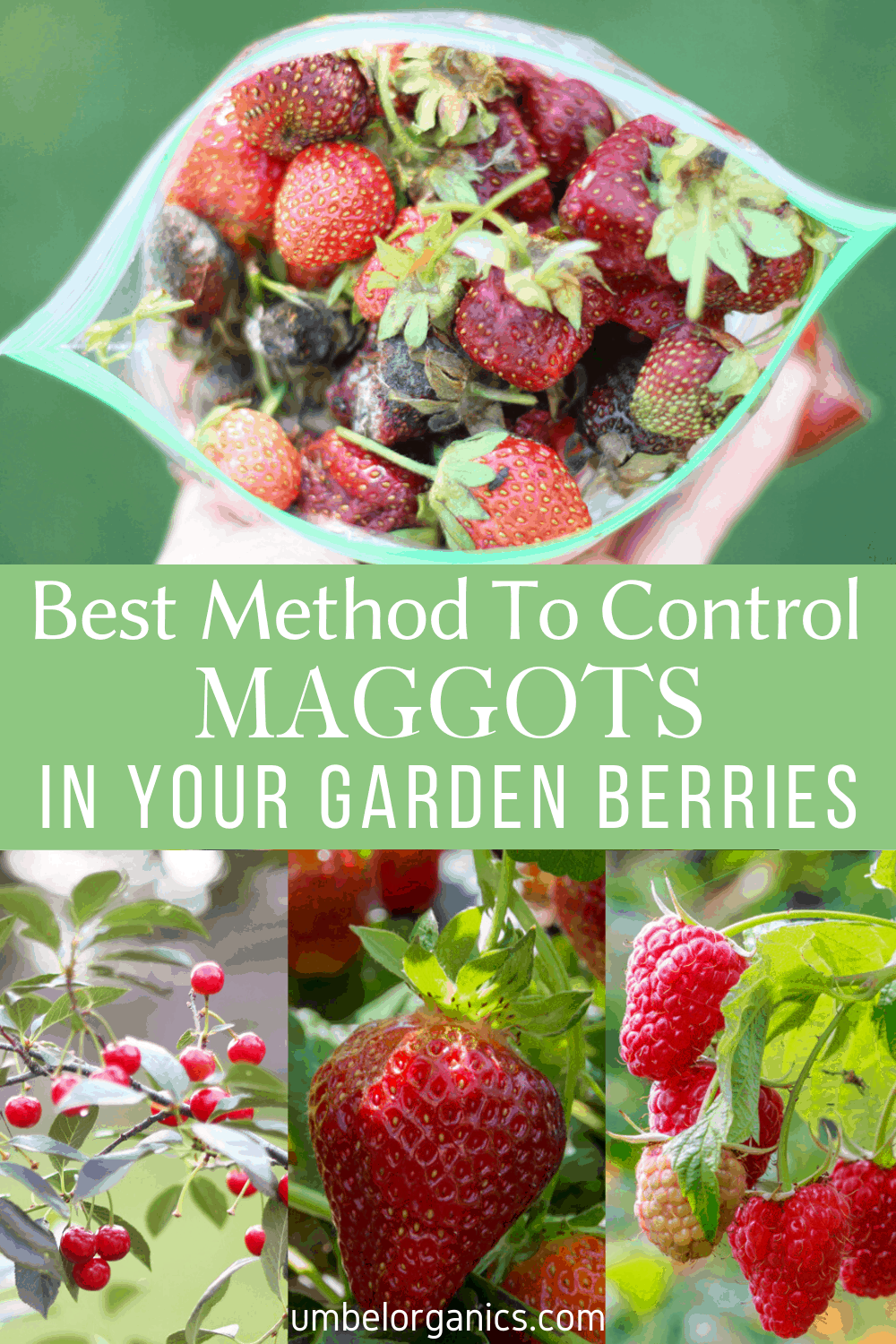What Is Ruining The Berries In My Garden?
There’s nothing worse than eyeing a beautifully ripe strawberry in your garden only to find that that the bottom has turned to mush. We’ve got the scoop on this devious garden pest and have devised the BEST method to control it. This strategy is simple and completely organic—no harmful chemicals needed!
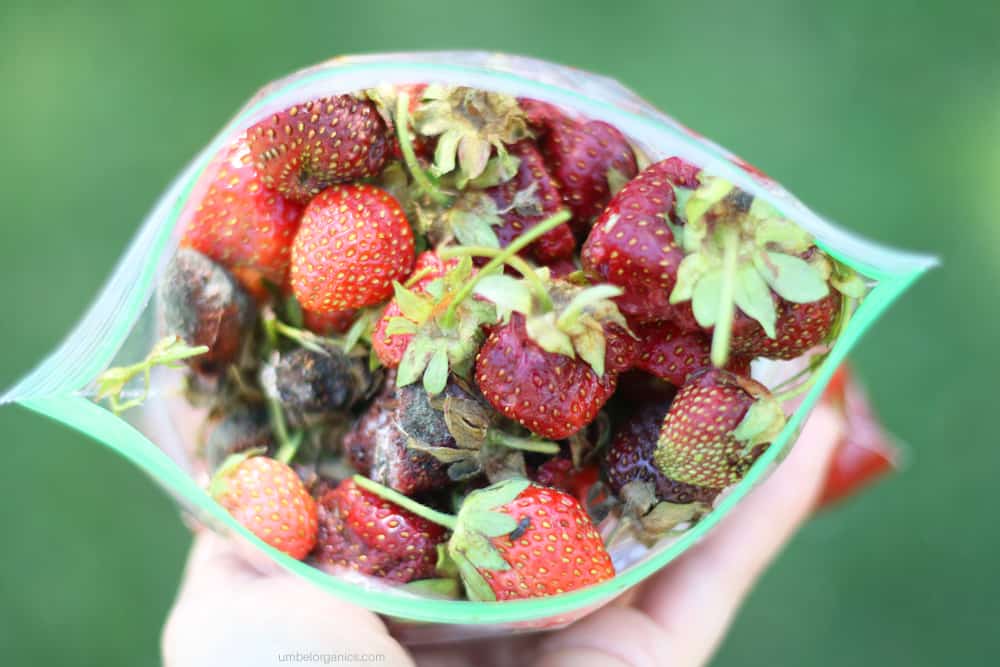
Disclosure: This post contains affiliate links, which means if you make a purchase through these links, we may receive a small commission at no extra cost to you.
Have your fruit crops started turning soft and mushy? The culprit is most likely spotted wing Drosophila (Drosophila suzukii).
This pest has recently been introduced to North America from its native range in Asia. It has spread rapidly to nearly all 50 states in the US, where it is a serious pest of soft summer fruit.
If you have it in your garden, you know what I mean by serious. This fly can WIPE OUT AN ENTIRE FRUIT CROP in a matter of days. If you are battling spotted wing Drosophila in your garden, you’ve come to the right place.
Lucky for us, Jeremy is a Drosophila biologist—yep, his lab is full of vials of Drosophila including spotted wing Drosophila. He has devised a strategy to control this pest in the home garden. This strategy is simple and completely organic—no harmful chemicals needed. Read on to get the inside scoop.
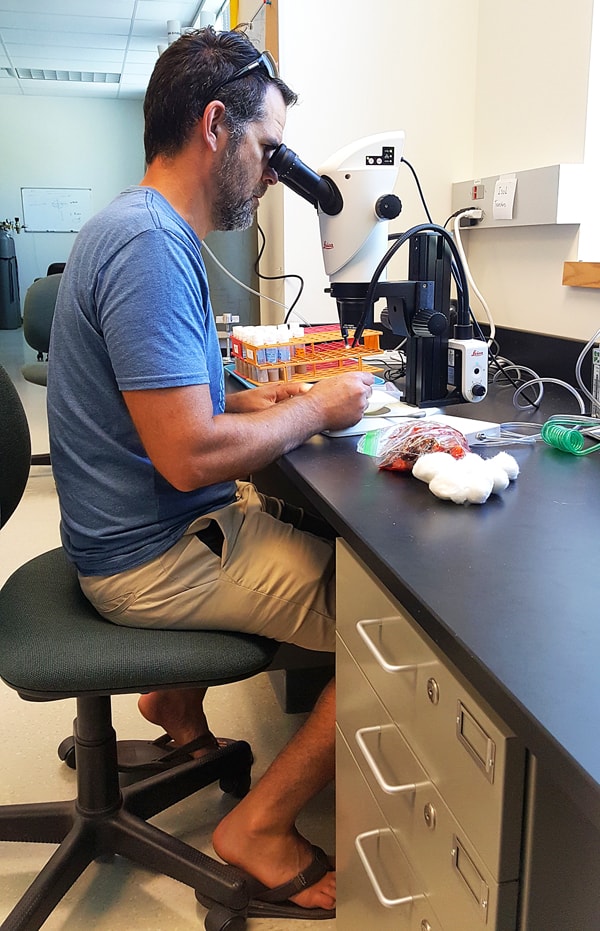
What Fruit Does Spotted Wing Drosophila Target?
Spotted wing Drosophila will target nearly all small fruits and berries. For the home gardener, this includes Strawberries, Raspberries, Blackberries, Blueberries, Grapes, and Cherries.
Unlike other Drosophila, which breed in already rotten substrates, spotted wing Drosophila females lay eggs in ripening fruit. The larvae will then feast on the fruit, eventually turning it to mush or making it susceptible to mold or other pathogens.
How Do You Know You Have Spotted Wing Drosophila In Your Garden?
There are not many garden pests that will damage ripening fruit in the same manner as spotted wing Drosophila. So, chances are, if your fruit is turning soft before it is ripe, you have an infestation.
Sometimes infested fruit can be overtaken by mold or other pathogens, but this is a red herring—spotted wing Drosophila is the real culprit.
To further confirm you have this pest you can open up infested fruit and look for the white larvae (maggots). Depending on the stage of development, larvae can range in size from microscopic to something you can easily see with your naked eye (see picture below).
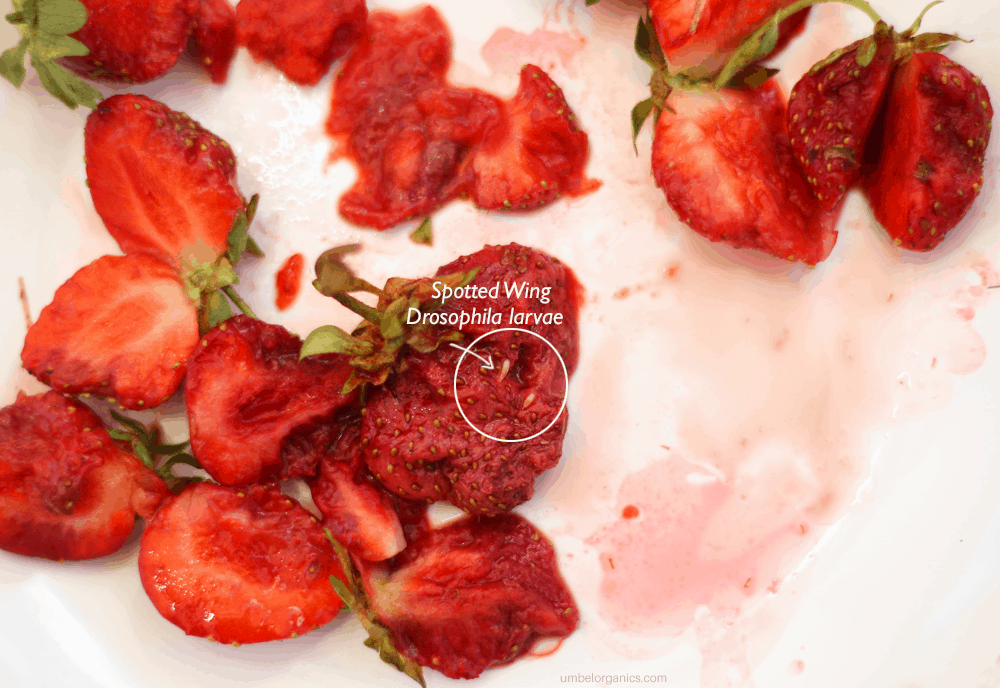
You can also look for adult flies around your fruit. While the females are difficult to distinguish from other Drosophila species without a microscope, the males have dark spots on their wings.
There are some other Drosophila species with spotted wings, but if you have an infestation of ripening fruit and you find flies with spotted wings, you almost certainly have spotted wing Drosophila in your garden.
What If I Accidentally Eat Infested Fruit?
Don’t worry. There are no known risks of eating infested fruit. Last year I ate an entire handful of raspberries before I realized they were infected. Aside from tasting a little “off”, I had no ill effects.
Eventually the fruit becomes so soft and damaged that you would be unlikely to eat it, but at the early stages of larval development it can be difficult to detect whether a fruit is infested.
Controlling Spotted Wing Drosophila In Your Garden
The easiest way to control this pest is to plant varieties that will fruit before spotted wing Drosophila numbers are high enough to cause problems. Since SPOTTED WING DROSOPHILA was introduced to the US only in the last decade, we are still learning about factors that drive seasonal fluctuations in this garden pest.
In regions that experience cold winter temperatures, like Colorado, Drosophila populations may take a long time to build up to damaging numbers. In zone 5, we don’t see evidence of this pest until the first few weeks in July.
This means our June-bearing strawberries are usually unaffected, or only get infested at the tail-end of the harvest. If you live in a cold winter region and want to grow strawberries, we highly recommend trying JUNE-BEARING varieties. You’ll have the best chance of harvesting your fruit before the flies arrive.
Everbearers or Day-neutral varieties will fruit over a longer season, and you will most likely to have to contend with significant pest damage.
Many other types of fruit ripen later in the season, and spotted wing Drosophila can quickly infest late summer fruit crops. We grow RASPBERRIES, which produce a large fall crop. All is not lost—it is still possible to enjoy a delicious berry harvest even with spotted wing Drosophila lurking about!
The key is to understand the LIFE CYCLE of the spotted wing Drosophila. The females lay eggs in ripening fruit.
A single female can lay more than 20 eggs a day over the course of several weeks. The larvae that hatch from the eggs will feed on your ripening fruit for a little less than a week before they pupate and eventually emerge as adults.
The whole process takes about 10 days in warm summer temperatures. The population infesting your garden can grow exponentially in a matter of just a few weeks unless you do something about it.
The #1 Rule
- Never let the flies complete their life cycle. If you find infested fruit, pick it immediately! If you leave it, you are allowing the next generation of flies to develop unchecked in your garden.
- When we detect an infestation, we go out in the garden every evening and pick infested fruit, toss it in a Ziploc bag, and put the bag in the freezer to kill any developing flies. If you use this simple strategy, you will ensure that the population infesting your garden does not build exponentially over time.
- But, you still have adult females buzzing about laying eggs in your fruit. The key is to trap the adults in your garden so they can’t do more damage. This is simple to do. You can use pretty much any container, but 2 liter soda bottles work really well for this purpose. They seem to prefer green bottles to clear, although both will work. Cut a small flap in one side of the bottle as pictured below.
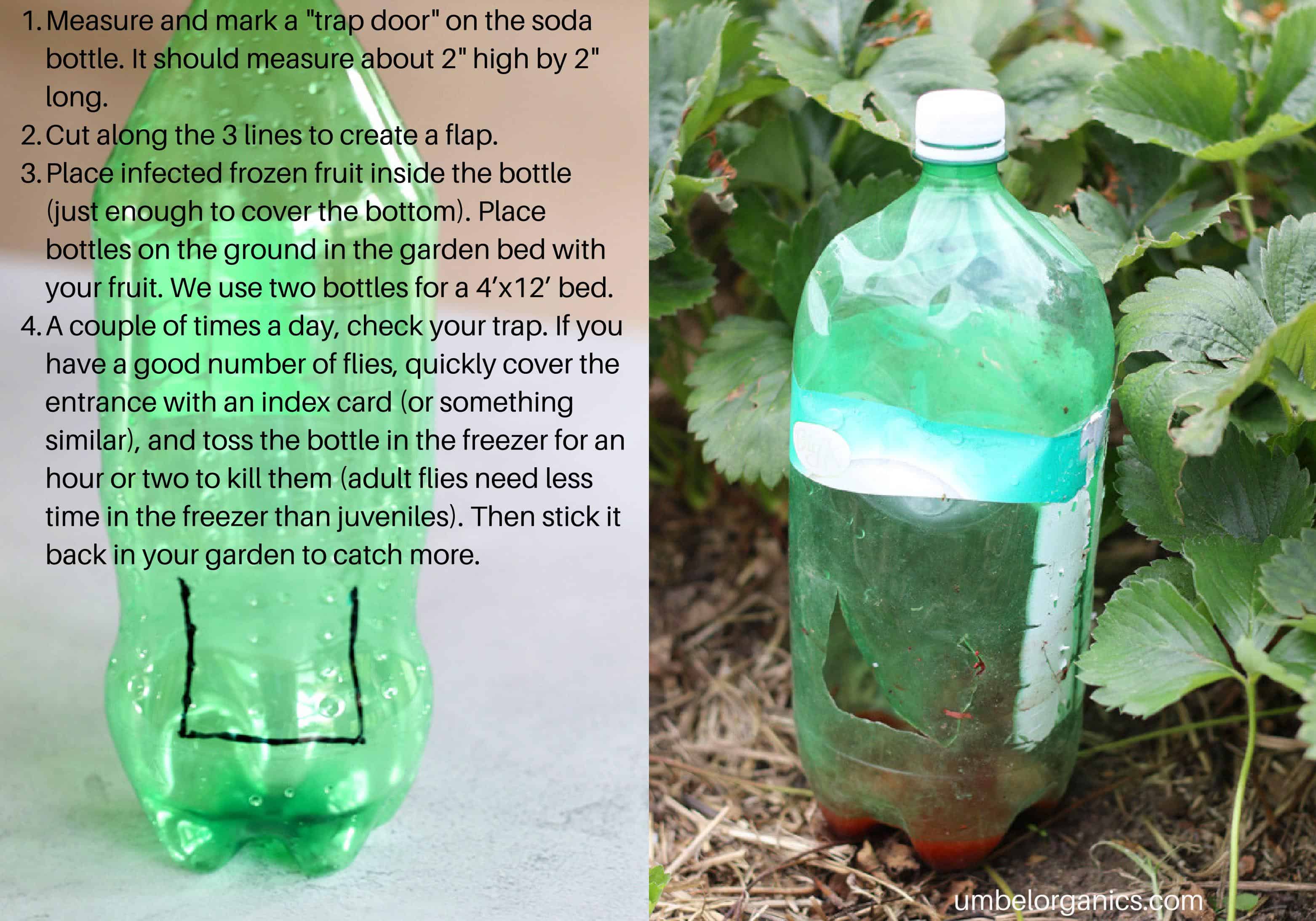
Remember the infested fruit that’s in a Ziploc bag in your freezer? Place that fruit inside the bottle (just enough to cover the bottom).
Make sure it’s been in the freezer for AT LEAST 8 hours to ensure any developing flies are dead. Place the soda bottles on the ground in the garden bed with your fruit. We use two bottles for a 4’x12’ bed. We recommend shading the bottles with foliage.
Adult flies will smell the fruit and enter the bottle, where they will hang out. A couple of times a day, check your trap. If you have a good number of flies, quickly cover the entrance with an index card (or something similar) and tape it on with Scotch tape.
Toss the bottle in the freezer for an hour or two to kill the flies (adult flies need less time in the freezer than juveniles).
After this step, put the soda bottle back in your garden to catch more flies. You will catch the most flies in the morning and evening.
At first, you will probably catch a lot of flies. But, over the course of a few days, you should see the fly numbers start to decline—this means the strategy is working!
If you continue to pick infested fruit so that new flies can’t develop in your garden and you capture most of the adults, then you can control the population to a level that will not do major damage to your crop.
Before we implemented this strategy about 90% of our raspberries were infested. With our soda bottle approach, 10% or less of our fruit is infested. It really works! The best thing about this strategy is that it is totally ORGANIC, and requires minimal effort.
Please keep us posted and let us know how it works for you.
